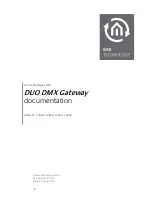
Gateway Settings
79
The best MTU setting for your gateway is often the default value. In some situations, changing
the value fixes one problem but causes another. Leave the MTU unchanged unless one of
these situations occurs:
You have problems connecting to your ISP or other Internet service, and the technical support
of either the ISP recommends changing the MTU setting. These web-based applications might
require an MTU change:
●
A secure website that does not open, or only part of a web page displays
●
Yahoo! Mail
●
MSN portal
●
America Online’s DSL service
●
You use VPN and have severe performance problems.
●
You used a program to optimize MTU for performance reasons, and now you have
connectivity or performance problems.
●
An incorrect MTU setting can cause Internet communication problems. For example, you
might not be able to access certain websites, frames within websites, secure login
pages, or FTP or POP servers.
If you suspect an MTU problem, a common solution is to change the MTU to 1400. If you are
willing to experiment, you can gradually reduce the MTU from the maximum value of 1500 until
the problem goes away. The following table describes common MTU sizes and applications.
The following table lists common MTU sizes.
MTU Size
Application
1500
The largest Ethernet packet size. This setting is typical for connections that
do not use PPPoE or VPN, and is the default value for NETGEAR gateways,
adapters, and switches
1492
Used in PPPoE environments
1472
Maximum size to use for pinging. (Larger packets are fragmented.)
1468
Used in some DHCP environments.
1460
Usable by AOL if you do not have large email attachments, for example.
1436
Used in PPTP environments or with VPN.
1400
1400 Maximum size for AOL DSL.
















































